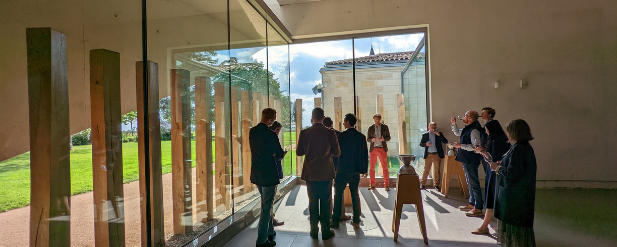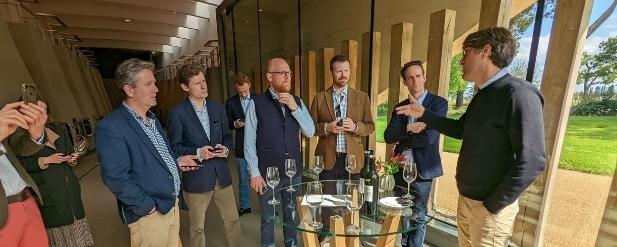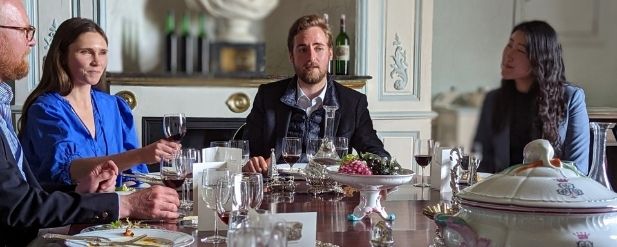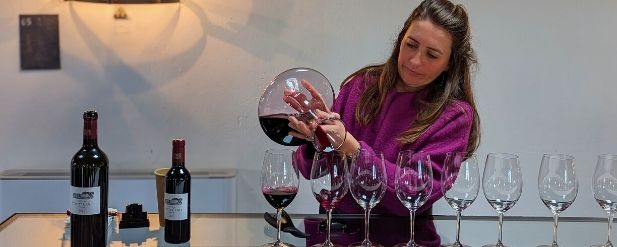
Bordeaux 2021: An insight from our Head of Sales, George Wilmoth
11 May 2022
George Wilmoth
The narrative about Bordeaux en primeur often begins long before we’ve tasted the wines. Every slight change in weather is seized on as an indicator of success, or failure, with disaster stories dominating opinion. It can often be quite hard to separate what you’ve read from the reality of the vintage. If 16 years tasting primeur wines has taught me anything, it’s that great wines are made under even the most challenging conditions.
We approached our tasting of the 2021 vintage with a mixture of excitement, curiosity and just a touch of the UK wine trade’s typical cynicism. Most UK merchants I bumped into on the trip were simply happy to be back tasting fresh barrel samples in Bordeaux again. It was good to catch up with friends and to see the huge changes at chateaux. There have been some very swanky new cellars built over the past couple of years!
Our itinerary was packed. We spent four days tasting, mostly at chateaux, getting the lowdown first-hand. Over the first few days a clearer picture of the vintage emerged. Whilst the vintage had clearly presented challenges for many properties, it also delivered the opportunity to craft something very different from the vintages that preceded it. Ten years ago, a vintage like this might have presented a real threat to a winemaker, but these days they are more experienced and much better prepared.
I suspect 2021 will have reshaped some winemakers’ concepts of quality and style. For me, the hallmarks of the vintage are freshness, low alcohols (often circa 13% or less), fine tannin and a core of pure, cool fruit. They are not blockbuster wines, but they are fresh, vibrant and exciting. A modern interpretation of a very good, classically styled vintage. I think they may well appeal to the key British critics and William Kelley (who now heads up Bordeaux for the Wine Advocate) shares my enthusiasm. He writes, “while 2021 isn’t a great vintage, it has produced several genuinely great wines, as well as many good to excellent wines that will deliver immense pleasure.” I think they will certainly appeal to many Bordeaux drinkers who’ve enjoyed wines from the 80s, 90s and early 00s. If I had to pick a few similar vintages for the sake of comparison, I’d reach for 1996, with a dollop of 2000, a squeeze of 1988 and a sprinkling of 2001, vintages which are all delivering a huge amount of pleasure now. These are going to be wines that you will want to drink. The lower alcohols are a big plus and the oak profile at many properties was markedly different from previous years, as the lower alcohols generally meant less oak extraction. I like the vintage’s lower alcohol and freshness, which brings a sense of delicacy and finesse to many properties that you would not associate those qualities with, and I think the vintage will present many collectors with an opportunity to discover and enjoy chateaux they haven’t previously followed.
Wine merchants, brokers and collectors are often guilty of monetising en primeur campaigns. Yes, we all want a good deal, and it probably makes that bottle taste just a little bit sweeter when you think back to what you paid for it on release, but wine is ultimately about drinking and pleasure. Years of Parkerisation has taught us to swoon over hot, ripe vintages with “globs of fruit”. In the early days of Parker, there was certainly something to be said for this style – most vintages struggled for maturity. Fast forward twenty years and ripeness is almost a given. What we look for now is finesse, freshness, drinkability. And dare we say it, the style of the best 2021s is likely to be more enjoyable in the 10-20 year medium term than some “blockbuster” vintages with 15%+ alcohol. Our perception is changing. Customers are already quite savvy about alcohol levels and yearn for the dialled back elegance of yesteryear. 2021 is the first vintage we can recall that blends classical grace with modern tannins – a brilliant combination.
A word of caution. 2021 is not a consistent vintage. Terroir, financial resources and technical know how tend to be the determining factors. Take the Margaux appellation for example. Margaux, Palmer, Rauzan Segla and Brane Cantenac are all outstanding; sadly the rest of the region is disappointing. This pattern is repeated in every commune. To help steer you, I’ve compiled a list of my favourite left and right bank properties (in no particular order). It’s not an exhaustive list, and I’m sure there may be one or two properties I have omitted by mistake.

Troplong Mondot – The revolution continues here. Aymeric de Gironde has managed to bring a delicacy to the wine, and its often brooding tannin, that has never been seen before. Their new chai is breath-taking (quite literally if you have vertigo!).
Petrus – No surprises here, just great wine making from a great team.
Le Pin – As above. Fresh and classy.
Evangile – The best Evangile that I can recall trying EP. Yields were decimated, so it will likely be hard to secure.
Lafleur – Frontrunner for wine of the vintage. A giant core of vibrant dark fruit. Long, complex and satisfying. Les Perrieres – potentially better than (an excellent) Pensees. Pure limestone class.
Grand village – Almost certainly the best value red made in the vintage.
Angelus – A fresh, vibrant, black cherry, fruit-driven expression of Angelus. No over extraction. Lovely fine tannins. The kind of wine I wish they could make every year and a great example of a property that appeared to benefit from the conditions.
Figeac – Almost as impressive as their very swanky new cellar. Creamy, crunchy, red cherry fruit with a lovely cool core of darker fruit in the middle. Some fine, dry tannin on the finish should see the wine cellar well.
VCC – No surprise again. Guillaume and Alexandre Thienpont continue to make one of the best right bank wines in every vintage. Fresher and more chiselled than in recent years.
Canon – Concentrated, perfumed and harmonious. The vintage’s freshness works incredibly well here. Everything in its place. An outsider for wine of the vintage.
Belair Monange – I normally tend to put Trotanoy over Belair Monange but this year the B-M is the standout wine in the Moueix stable. Concentrated and creamy, black cherry fruit, underscored by a vibrant acidity and lithe tannins. Oooh la la.
Ausone – Another candidate for wine of the vintage. Deep and rich, really brought to life by a vibrant acidity. It’s got a purity and tension that's been absent in more recent vintages.
Cheval Blanc – A great team on a roll. Fresh, concentrated black fruit, and a lovely mocha laden finish, all underpinned by lots of fine tannin.
Pavie – Yes, that’s right Pavie! The groundwork had been laid over the last few vintages, but the more pared back winemaking is really paying dividends here. There’s freshness, purity and precision. The tannins have been well handled. It’s really exciting thinking where this property could go.
Eglise Clinet – Denis’s daughters Constance and Noemie now helm this property with the help of Denis’s long-term right-hand man, Olivier Gautrat. Together, they’ve not missed a beat and all the classic EC characters are there, if anything I think they might have dialled back a little of the dense blue fruit character here. Petite Eglise strong too, as is Montlandrie.
Beauregard – This had impressed over the last few vintages, and I think the vintage profile of acidity and plentiful fine tannin really works to the property’s strengths. Normally, inexpensive for the right bank and an excellent choice for more regular drinking while you wait for the more illustrious wines to hit their drinking windows.

Haut Brion – The 1996 instantly springs to mind here. The most ethereal and elegant of the first growths, though there’s still plenty of power.
Haut Bailly – I normally find Haut Bailly a little too foursquare for my liking, but this was absolutely wonderful with bags of blackberry and liquorice notes and cashmere textured tannins.
Calon Ségur – I expected to find a wall of tannin here but instead there was a bright core of vanillin laced black fruit and fine tannin. Capbern eclipsed the 2nd wine too.
Mouton Rothschild – This bought to mind a fresh, classically styled and impressive vintage of Mouton like 1998 (a wine which is drinking very well now!). A must for all Pauillac lovers.
Grand Puy Lacoste – A brilliant, brilliant GPL. Reminiscent of the superb 1996. Classic Pauillac notes of blackcurrant, cassis and a touch of smoky cedar. There was universal agreement among the 12 of us tasting that this is one of the best GPLs we’ve tasted in a while. Their second wine, Lacoste Borie was also brilliant.
Lafite Rothschild – My first growth of the vintage, just edging out Margaux. The team here is one of the best in Bordeaux. A touch of mocha wood, tinged with new leather. Lots of harmony and power. Sappy black fruit. Long and complete. Epic stuff.
Duhart Milon – The best Duhart I think I’ve ever tried. Just a notch behind GPL in quality. Textbook Pauillac. Moulin de Duhart will be released for the first time ever at EP and it’ll be a excellent house red for Pauillac lovers.
Pichon Lalande – Candidate for best wine outside the Firsts). Classic Pauillac with slightly more seductive tannins than its peers. Once again Nico Glumineau and his team have not put a foot wrong.
Pichon Baron – While definitely behind Lalande, Baron always gains weight and generosity in bottle. It’s bigger and burlier too but it will age very well.
Branaire Ducru – This caught us a little by surprise as it’s not a property that’s garnered much attention in recent years but there was plenty of bright crunch red fruit here and some well managed tannins. It should show well in 10 or so years.
Gruaud Larose – Another surprise. Bright, vibrant black fruit and fine tannin. A touch modern but in a good way. One of the best wines from here in a while.
Leoville & Langoa Barton – Both solid wines that should appeal to fans of the property. Langoa has a slightly riper, more generous character.
Leoville Las Cases - A very aristocratic, poised LLC with lots of crunchy blue fruit and fine tannins. 2001 with a touch of 1996 would make a nice comparison here.
Montrose – A brilliant wine. Perfumed and elegant. This is a world away from the bigger more boisterous vintages like 2009 or 2015, 2016. I loved it. Fresh, dark black fruit. Precise. Lovely delineation. A St Estephe for Pauillac lovers.
Tronquoy Lalande – One of the candidates for top value pick of the vintage. Alas, fans will have to wait, this isn’t released en primeur.
Margaux – Predictably brilliant. Perfumed and feminine. Wonderful crunchy, blue fruit character. Fine boned. There's a very pure blackcurrant fruit element on the mid palate. Fine dry tannins. Excellent length.
Palmer – Full of pure, creamy blue fruit with a solid, crunchy core and excellent intensity mid-palate intensity. Plentiful fine dry tannins.
Rauzan Ségla – Having tasted Canon and loved it (made by the same team), we had high expectations of Rauzan. We weren’t disappointed. It’s packed full of crunchy black fruit, and there’s plenty of weight on the mid palate. The tannins are fine and everything’s in harmony. Another strong showing for Margaux, which is probably the most successful appellation.
Brane Cantenac – We’ve been fans of Brane for a while. It has a lovely perfumed, floral, blue fruit character. A classic vintage in a modern style.

The Haut Brion stable - A faultless selection of whites. Low yields. Will likely be hard to get at the top end. I couldn’t spit any of these, they were just delicious.
Haut Brion Blanc – White wine of the vintage. Taut, pure, precise with a fantastic long finish. The oak is more subtle than normal here. If you drink one bottle from a case, you’ll struggle to drink the rest.
Mission Haut Brion Blanc – Just a fraction behind HBB
Clarté Haut Brion – Very expressive with plenty of vibrant tropical notes. It will be delicious young.
Grand village – Almost certainly the best value white made in the vintage.
Champs Libres – First growth quality a fraction of the price. Wood toned down this year, which allows the fruit to really sing.
Pavillon Blanc de Chateau Margaux – Taut, electric lemon-driven fruit with just the merest hint of oak. Debatably sits just behind Haut Brion Blanc for top white wine. Yields are miniscule this year. Will likely require a Machiavellian level of cunning to secure an allocation.
Production is going to be absolutely miniscule. Only 16 properties made wine, with most properties being absolutely decimated by the frosts and hail. They are generally excellent wines but due to the tiny yields they will be very hard to get. I might wait to see what we are able to offer before I get you too excited …



